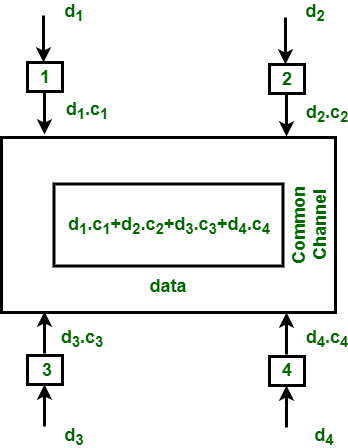
In communication systems, FDMA, TDMA, and CDMA are three different methods used to share a single communication channel among multiple users. Understanding these methods helps us see how multiple users can efficiently share communication channels without interference.
FDMA (Frequency Division Multiple Access) divides the channel into separate frequency bands for each user. TDMA (Time Division Multiple Access) assigns different time slots to each user on the same frequency. CDMA (Code Division Multiple Access) uses unique codes to differentiate users sharing the same frequency band at the same time. In this article, we are going to discuss the differences between these communication channels in detail.
Frequency Division Multiple Access (FDMA): FDMA is a type of channelization protocol. This bandwidth is divided into various frequency bands. Each station is allocated a band to send data and that band is reserved for the particular station for all the time which is as follows.

The frequency bands of different stations are separated by small bands of unused frequency and unused frequency bands are called as guard bands that prevent the interference of stations. It is like the access method in the data link layer in which the data link layer at each station tells its physical layer to make a bandpass signal from the data passed to it. The signal is created in the allocated band and there is no physical multiplexer at the physical layer .
Time Division Multiple Access (TDMA) : TDMA is the channelization protocol in which bandwidth of channel is divided into various stations on the time basis. There is a time slot given to each station, the station can transmit data during that time slot only which is as follows.

Each station must aware of its beginning of time slot and the location of the time slot. TDMA requires synchronization between different stations. It is type of access method in the data link layer . At each station data link layer tells the station to use the allocated time slot.
Code Division Multiple Access (CDMA) : In CDMA, all the stations can transmit data simultaneously. It allows each station to transmit data over the entire frequency all the time. Multiple simultaneous transmissions are separated by unique code sequence. Each user is assigned with a unique code sequence.

In the above figure, there are 4 stations marked as 1, 2, 3 and 4. Data assigned with respective stations as d 1 , d 2 , d 3 and d 4 and the code assigned with respective stations as c 1 , c 2 , c 3 and c 4 .
| FDMA | TDMA | CDMA |
|---|---|---|
| FDMA stands for Frequency Division Multiple Access. | TDMA stands for Time Division Multiple Access. | CDMA stands for Code Division Multiple Access. |
| In this, sharing of bandwidth among different stations takes place. | In this, only the sharing of time of satellite transponder takes place. | In this, there is sharing of both i.e. bandwidth and time among different stations takes place. |
| There is no need of any codeword. | There is no need of any codeword. | Codeword is necessary. |
| In this, there is only need of guard bands between the adjacent channels are necessary. | In this, guard time of the adjacent slots are necessary. | In this, both guard bands and guard time are necessary. |
| Synchronization is not required. | Synchronization is required. | Synchronization is not required. |
| The rate of data is low. | The rate of data is medium. | The rate of data is high. |
| Mode of data transfer is continuous signal. | Mode of data transfer is signal in bursts. | Mode of data transfer is digital signal. |
| It is little flexible. | It is moderate flexible. | It is highly flexible. |
In conclusion, FDMA, TDMA, and CDMA are different methods to allow multiple users to share the same communication channel without interference: FDMA divides the channel into different frequency bands for each user. TDMA assigns different time slots to each user on the same frequency. CDMA uses unique codes to differentiate users sharing the same frequency band at the same time. Each method has its strengths and weaknesses, and the choice of method depends on the specific needs and constraints of the communication system. Understanding these methods helps us appreciate how multiple users can communicate efficiently and effectively.
Full form of FDMA is Frequency Division Multiple Acces.
FDMA can work with both analog and digital signals, but it is usually used with analog signals.
TDMA (Time Division Multiple Access) allows multiple users to share the same frequency by dividing the channel into time slots and assigning each user a different time slot.
FDMA divides the channel by frequency, TDMA divides the channel by time, and CDMA divides the channel by unique codes.